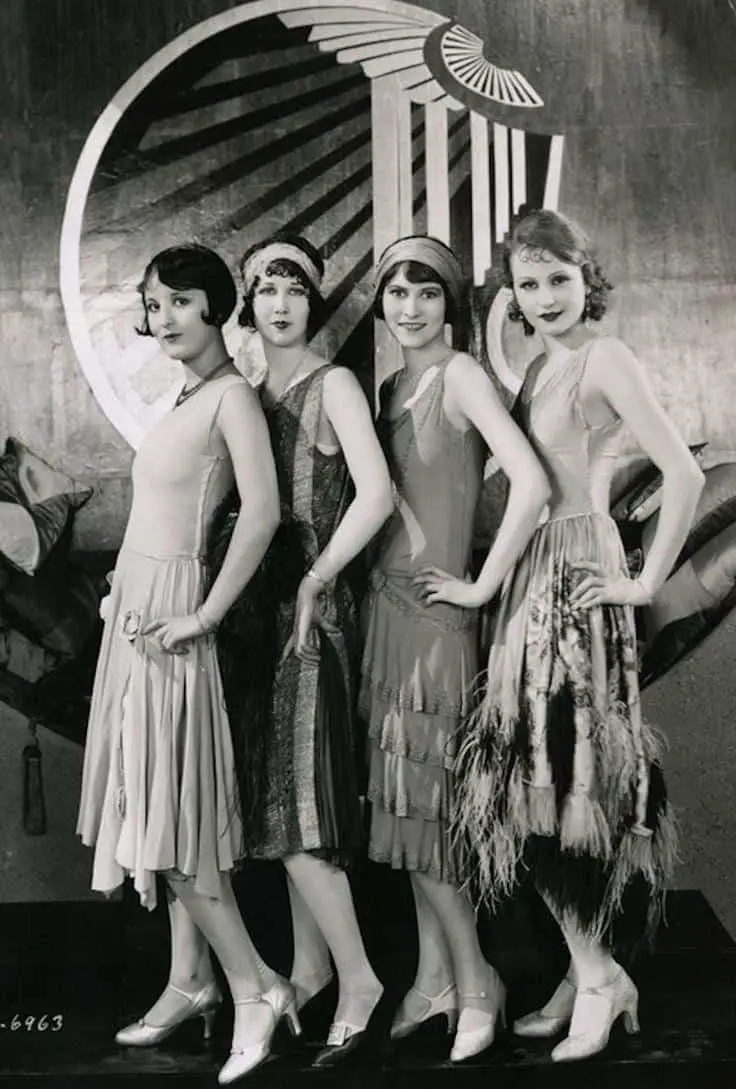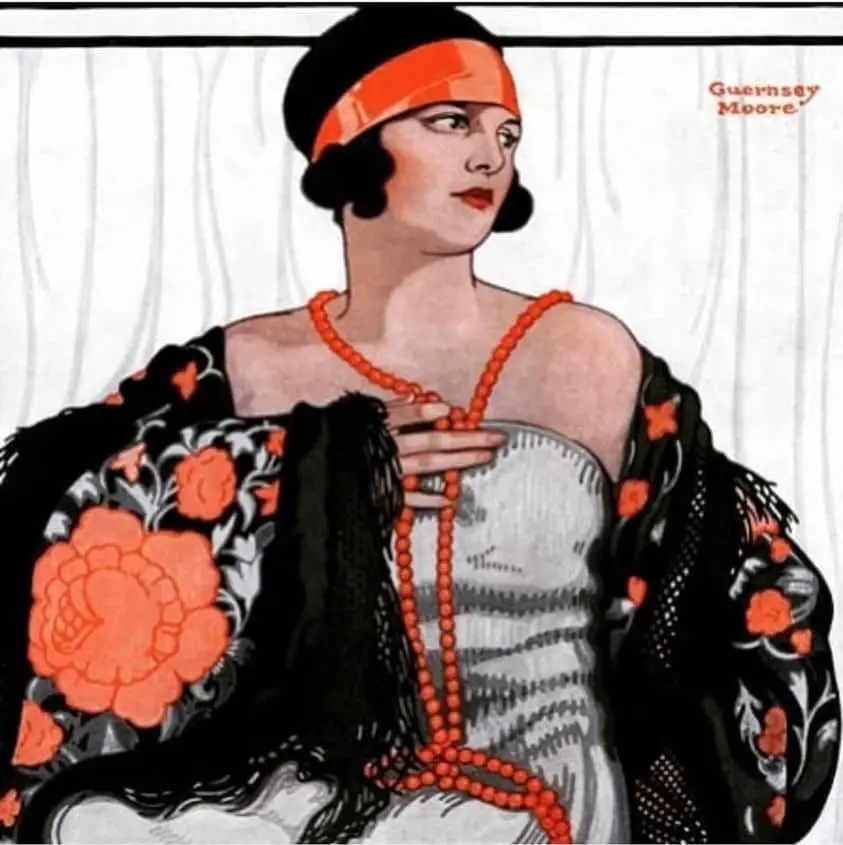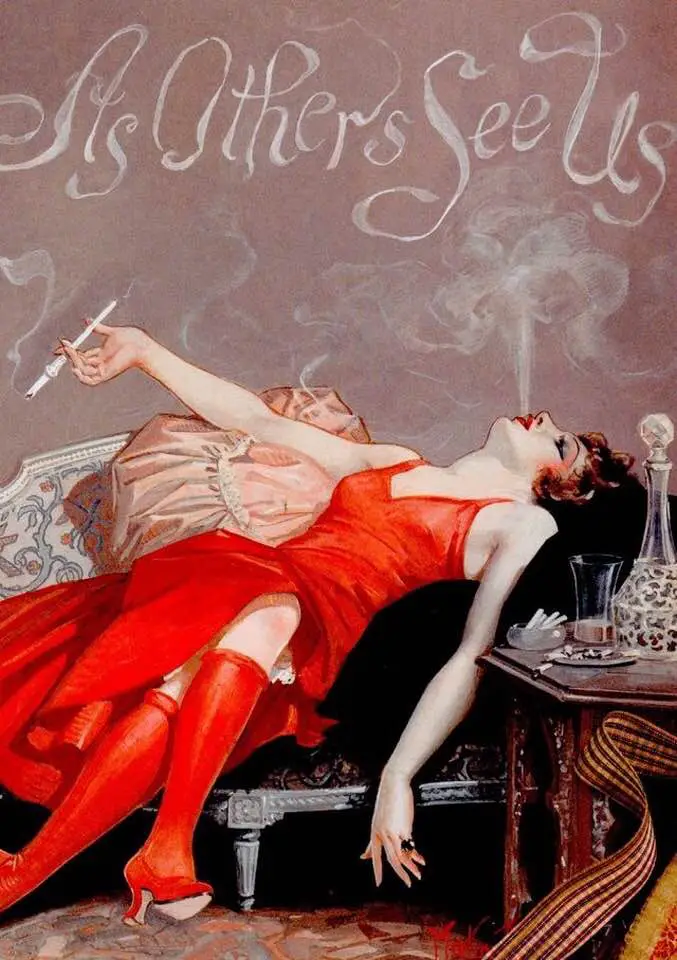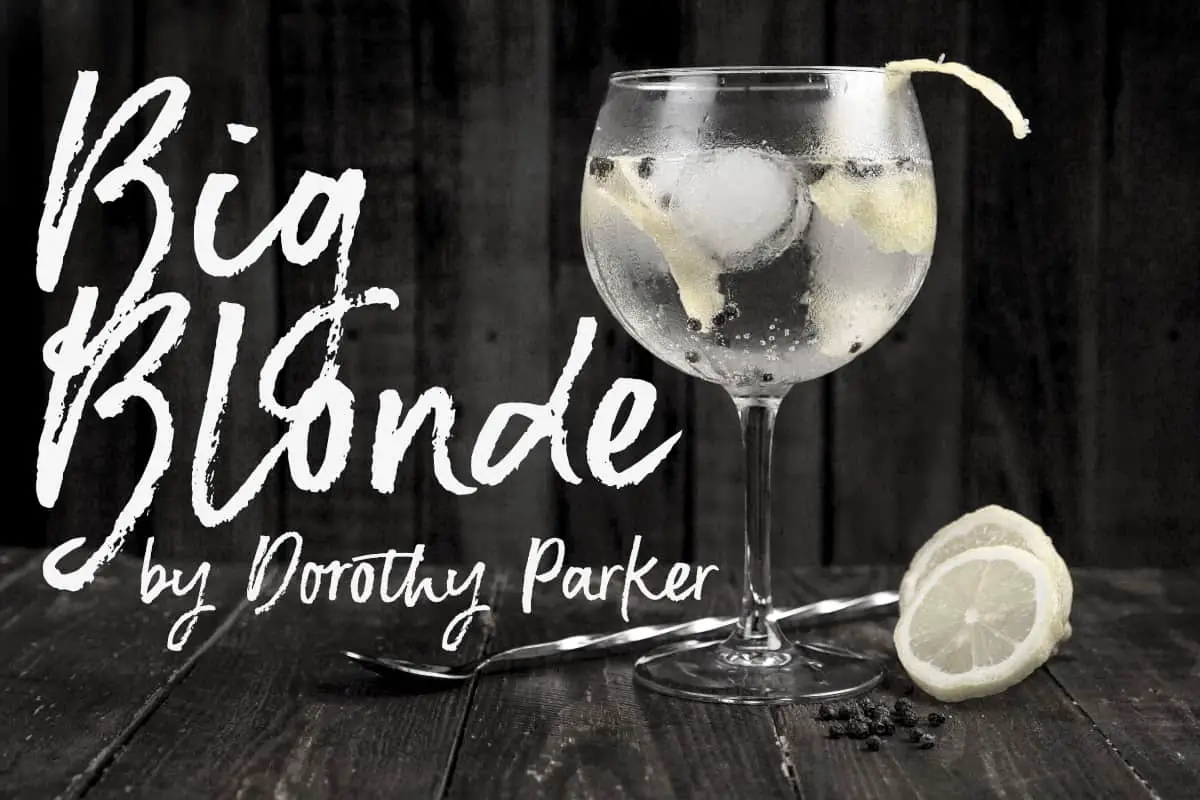“Big Blonde” (1929) by Dorothy Parker is a short story in five parts, included in various collections. We can read it for free online. The ‘Good Sport’ girl is the grandmother of Gillian Flynn’s ‘Cool Girl’.
When Gillian Flynn published Gone Girl, our culture had a new phrase to describe the kind of woman who spends her time modifying herself to men’s fantasies: The Cool Girl:
“Men always say that as the defining compliment, don’t they? She’s a cool girl. Being the Cool Girl means I am a hot, brilliant, funny woman who adores football, poker, dirty jokes, and burping, who plays video games, drinks cheap beer, loves threesomes and anal sex, and jams hot dogs and hamburgers into her mouth like she’s hosting the world’s biggest culinary gang bang while somehow maintaining a size 2, because Cool Girls are above all hot. Hot and understanding. Cool Girls never get angry; they only smile in a chagrined, loving manner and let their men do whatever they want. Go ahead, shit on me, I don’t mind, I’m the Cool Girl.
Men actually think this girl exists. Maybe they’re fooled because so many women are willing to pretend to be this girl. For a long time Cool Girl offended me. I used to see men – friends, coworkers, strangers – giddy over these awful pretender women, and I’d want to sit these men down and calmly say: You are not dating a woman, you are dating a woman who has watched too many movies written by socially awkward men who’d like to believe that this kind of woman exists and might kiss them. I’d want to grab the poor guy by his lapels or messenger bag and say: The bitch doesn’t really love chili dogs that much – no one loves chili dogs that much! And the Cool Girls are even more pathetic: They’re not even pretending to be the woman they want to be, they’re pretending to be the woman a man wants them to be. Oh, and if you’re not a Cool Girl, I beg you not to believe that your man doesn’t want the Cool Girl. It may be a slightly different version – maybe he’s a vegetarian, so Cool Girl loves seitan and is great with dogs; or maybe he’s a hipster artist, so Cool Girl is a tattooed, bespectacled nerd who loves comics. There are variations to the window dressing, but believe me, he wants Cool Girl, who is basically the girl who likes every fvcking thing he likes and doesn’t ever complain. (How do you know you’re not Cool Girl? Because he says things like: “I like strong women.” If he says that to you, he will at some point fvck someone else. Because “I like strong women” is code for “I hate strong women.”)”
SETTING OF “BIG BLONDE”
Dorothy Parker offers us the early 20th century version of The Cool Girl, who’s really not so different from Gillian Flynn’s early 2000s version. Parker calls her the Big Blonde, in line with pin-up fantasies at the time. The men call her a ‘good sport’. The phrase used to refer to sex workers (and adjacent cottage industries) of the time was ‘sporting woman’, which says a lot, I think. These ‘sporting women’ were ‘cool girls’. They were women who’d go along with what a man wanted, and what men wanted was often sex, which gave rise to the euphemism.
Parker’s story focuses on the psychology of a woman in transition, from Cool Girl to Middle Aged Lonely Woman.
Parker wrote this story at an interesting time for beauty politics. This is a woman whose larger build was considered attractive during her youngest years as an adult, but who found the culture shifted around her to idealise the slim, boyish silhouette. 1920s Western fashion preferred the slim, straight-up-and-down body type found more typically in men than in women, but revered in women all the same.



To avoid placing undue emphasis on our bodies, it’s important we all understand the extent to which women’s BMIs (in particular) have always been judged according to external beauty standards which are nothing to do with some inherent measure of health and unchanging beauty, but everything to do with external forces. For instance, in times of famine and epidemic, women are expected to be fatter. In times of plenty, women are expected to be slimmer. This ‘perfect body’ has constantly changed all throughout history.
And sometimes it changes in a single lifetime. Dorothy Parker was around to see that, and in Big Blonde she writes a portrait of how that milieu can affect a woman on the level of the individual. Parker grew up in an America which idealised The Gibson Girl (not a real person but an image) and then idealised the Flapper.
Of course, beauty standards don’t just change from era to era — they also vary according to place. This is a Western story, set in New York, around and bubbling and roiling of the first world war. It’s not easy now to imagine the psyche of living in such a tumultuous time. Alcohol was the socially acceptable drug of choice. Did the men in this story realise they’d be going off to war soon, some of them never to come back? “Big Blonde” is not a story about the war, but we can’t separate the state of the world from the actions of these individuals — their hedonistic recklessness may have had political influences.
The way men and women’s beauty is considered differently can be seen even at a linguistic level. Take the word ‘blonde’. I have in the past looked up a usage dictionary to understand whether it always needs an ‘e’ at the end or not. Here’s what my Australian usage dictionary says about that:
blond(e): There are two words concealed here. The first, blond, is a perfectly normal English adjective meaning fair, which can be masculine or feminine. The second, blonde, is an imported French noun, meaning a blond female. Those who use the word blond as a noun, meaning a fair male, should consider the situation with brunette. Its French male form, brunet, exists in The Australian Concise Oxford Dictionary but not in the language, i.e. the imported words apply only to females.
Whoever wrote this usage dictionary tries to put it nicely, but is forced to eventually just say it: We really only refer to women by their hair colour, not men. Male forms of blonde and brunette exist, but only technically. This is precisely why Dorothy Parker chose to use the word as her moniker for what Flynn calls the Cool Girl. This is a specifically feminist story — a portrait of a real life sexist trope, whom Parker sets up specifically to encourage critique.
Later in the century, Peggy Lee remade the 1921 song Dorothy Parker quotes in “Big Blonde”. Lee’s is my favourite version. The original sounds like something out of a horror movie.
NARRATION IN “BIG BLONDE”
The danger in writing a story like this: The reader might critique the individual, and not the culture who creates her. This is always a problem for a writer, especially a short story writer, in which it must be done concisely.
How does a writer get around the danger of misplaced critique? I believe there’s only one way to try and avoid it (and even then, we don’t achieve it for every reader): These stories are heavy on narration. In some stories, like John Cheever’s “Reunion”, for example, Cheever does nothing more than painting a scene via first person narrator. There’s no critique from an unseen narrator. Readers are left to draw our own conclusion, because the conclusion is shared by any decent human being: That the father in that story is an asshole, and the son did well to get him out of his life.
But “Big Blonde” is a critique of an aspect of culture rather than of a person, and a large chunk of readers will have never thought on this topic beforehand — the ways in which ridiculous, ever-changing beauty standards affect women as individuals, and the way young women are expected to do the emotional labour for men at the expense of knowing themselves. We have terms to describe these phenomena now — the term ’emotional labour’ is itself a new phrase. The term was coined by sociologist Arlie Hochschild in her 1983 book The Managed Heart: Commercialization of Human Feeling. 1920s readers would not have considered the concept unless they were especially astute, forward-thinking feminist types. The language did not exist. Therefore, in a story like “Big Blonde”, the typical reader required heavy guidance from a narrator.
This leads to an important question for short story writers to ask before we set out to write a story, or perhaps only in the revision. Have we critiqued an aspect of culture with which typical readers are already on board? Or are we saying something seldom considered and/or widely misinterpreted?
The answer to that will affect our choice of narration, and the ratio of action/dialogue to narrative summary.
STORY STRUCTURE OF “BIG BLONDE”
SHORTCOMING
Marriage was different in this era. Parker’s narrator explains that in this circle, husbands aren’t all that important to the women. She means as an emotional support. The men offered nothing of that sort. Of course husbands — or husband proxies — were vital for economic support. Women are unable to support themselves financially. If they do work they earn a pittance (even for the same work), there’s no social security for divorced or single women, and they’ve been brought up to rely on men. They can’t think and plan their way out of a culture in which women are meant to be breeders and homemakers.
Hazel needs emotional connection, but the tragedy is she never finds it.
Hazel is often shortened to ‘haze’, making it a symbolic name — this character lives in a haze of drunkenness.
DESIRE
Hazel initially wants to have fun with her husband in the same way she had fun as a young, attractive, single woman. But marriage requires a different set of skills. Neither Hazel nor her husband develop these skills, and the culture doesn’t encourage it, either.
Beneath the surface, Hazel wants human connection.
OPPONENT
Hazel’s opponents are the men who come in and out of her life. Her biggest opponent is her husband because she initially expects more from him. Subsequent men are absolved by Hazel’s absent expectations.
Hazel’s opponent is also the culture which values her for how she looks and what she can offer sexually to men.
Hazel’s opponent is alcohol.
PLAN
Hazel is an example of a main character whose plan is barely conscious let alone thought-out. The plan of an alcoholic is to lurch from one situation to the next, living in the moment, focussed only on the next drink.
This doesn’t make for a satisfying story on its own, but if other characters have their own plans, and these plans affect our main character, then that makes a story that works.
A woman without a plan for her life finds herself at the mercy of other people’s wishes for her. In Hazel’s case, she becomes a proxy ‘good sport’ wife, to complement men’s images of themselves, and to allow men to have both a domestic goddess at home and a sex kitten in private, in a culture which separates women into these binary categories.
BIG STRUGGLE
When a friend introduces her to barbiturates, she takes a whole lot of them and is knocked out cold for days.
The colored maid summons the doctor, who observes Hazel ‘couldn’t be killed with an axe’.
ANAGNORISIS
Hazel realises that killing herself isn’t easy and she must therefore bear the rest of her life in this way:
She dropped the card to the floor. Misery crushed her as if she were between great smooth stones. There passed before her a slow, slow pageant of days spent lying in her flat, of evenings at Jimmy’s being a good sport, making herself laugh and coo at Art and other Arts; she saw a long parade of weary horses and shivering beggars and all beaten, driven, stumbling things. Her feet throbbed as if she had crammed them into the stubby champagne-colored slippers. Her heart seemed to swell and fester.
NEW SITUATION
Hazel will go on living her life under the haze of alcohol.
Oh, please, please, let her be able to get drunk, please keep her always drunk.
MESSAGE OF “BIG BLONDE”
With this realisation and this new situation, Parker seems to be saying that alcohol helps some people to endure their lives. Living in a haze is one way to live. That’s just how it is. Some people live and die like that. This makes “Big Blonde” the opposite of a didactic tale.
I’m reminded of Helen Garner’s novel “The Spare Room” in which Garner explores the numerous ways to die slowly (of cancer). Dominant culture tells us we must accept that we’re going to die. Garner points out that many people never accept it, then they die anyway, and what’s wrong with that? That’s one way to do it.

